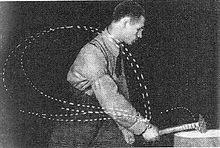

Nikolai Bernstein
| |
|---|---|
| Born | (1896-11-05)November 5, 1896 |
| Died | January 16, 1966(1966-01-16) (aged 69) |
| Resting place | Novodevichye Cemetery |
| Alma mater | Moscow State University |
| Scientific career | |
| Fields | Physiology |
| Institutions | Central Institute of Labour
Institute of Experimental Medicine |

Nikolai Aleksandrovich Bernstein (Russian: Никола́й Алекса́ндрович Бернште́йн; 5 November 1896 – 16 January 1966) was a Soviet neurophysiologist who has pioneered motion-tracking devices and formal processing of information obtained from the use of these devices. He was also one of first psychologists to suggest that behaviour is generative, constructive and not reactive. He was born and died in Moscow.
Nikolai Bernstein graduated high school in 1913. He was interested in languages and philosophy and wanted to be a linguist so he enrolled at Moscow University to study History and Philology. However, as World War I broke out in the summer of 1914, the Bernstein family felt the need to help their country during these hard times. Nikolai then took an alternative route in his education and started attending the medical college where he graduated in 1919 with a medical degree. Nikolai was then drafted into the Red Army as a doctor. After his service ended in 1921 his father helped him get a job as a physician at the Gilyarovsky Psychiatric Clinic till his father's death, he then took over his father's practice who was also a physician.[1]

His first scientific work was in 1922, when he, along with other researchers, were invited to study movement during manual labour in Moscow's Central Institute of Labour. The purpose of the study was to optimize productivity, and Bernstein's analysis focused on cutting metal with a chisel. He used cyclographic techniques to track human movement, a technique he would continue using for many of his experiments. His research showed that most movements, like hitting a chisel with a hammer, are composed of smaller movements. Any one of these smaller movements, if altered, affect the movement as a whole.
In 1926, Bernstein started a series of experiments that examined human walking. Originally, this work was to help with the engineering of pedestrian bridges. He studied the development of walking as humans matured and aged, and he also examined the gaits of those with brain damage.
In 1935, he received a Doctor of Science degree without submitting a thesis. He was also one of the first members of the USSR Academy of Medical Sciences, founded in 1944. In 1948, he was awarded the Stalin Prize for science.
Since he did his research behind the Iron Curtain of the USSR, his ideas only became known to Western scientists in the 1960s, when his seminal book, The Co-ordination and Regulation of Movements, was translated into English from Russian.
Bernstein was one of the pioneers in the field of motor control and motor learning inventing original devices that track the motion of people with and without experience in actions. The field of motor control basically studies how the Central Nervous System (CNS) controls posture and movement. Understanding how humans plan and control movement is a major challenge because of the large number of joints that provide the human musculoskeletal system with numerous kinematic degrees of freedom. Because the goal of most movement tasks, like moving a hand to a target, is defined in terms of a much smaller number of kinematic degrees of freedom, it can be achieved in an infinite number of different ways (also referred to as the 'inverse kinematics problem'). Furthermore, the number of muscles acting across a joint generally exceeds the number of kinematic degrees of freedom of that joint. As a result, a given movement can be realized with an infinite number of muscle activation patterns (also referred to as the 'inverse dynamics problem'). Even though a goal can be reached in an infinite number of ways, many studies have revealed very consistent and stereotypical patterns of kinematics and muscle activation. Evidently, the Central Nervous System (CNS) is capable of adequately controlling the many degrees of freedom. This question of how the CNS is capable of adequately controlling the many degrees of freedom of the musculoskeletal system was first addressed by Bernstein[2] and is now known as the 'Bernstein problem' (though distinct from Bernstein's problem in mathematics).
Bernstein suggested that the CNS is capable of "functionally freezing degrees of freedom." As an analogy, controlling the four wheels of a car independently is very difficult. Yet, by functionally freezing degrees of freedom (the two rear wheels are only allowed to rotate around one shared horizontal axis, and the two front wheels are also allowed to rotate in parallel around a longitudinal axis, controlled by the steering wheel) a car becomes much easier to control. Bernstein also did major work with motor learning, creating models for stages of learning. His work in the 1950s and 1960s was remarkably insightful and is still valid and respected today.
Bernstein is also famous for saying that "none of the actions is repeated but every action is constructed anew; it's just a matter what level regulates this construction". He proposed a theory of "levels of control over action construction" that later were echoed in levels of control in cognitive psychology.
He was likely very much influenced by the work of John Hughlings Jackson, who posited a hierarchical organization of the nervous system.
Bernstein work opened a new discipline called kinesiology that study the structure and mechanisms of motion. American kinesiologist Karl Newell is one of many to be greatly influenced by Bernstein. Newell (1986) arranged constraints into three main groups: Individual (structural or functional), task, and environmental constraints.[3]
Bernstein also coined the term biomechanics, the study of movement through the application of mechanical principles.
{{cite journal}}: Cite journal requires |journal= (help)
| International |
|
|---|---|
| National |
|
| Academics |
|
| People |
|
| Other |
|